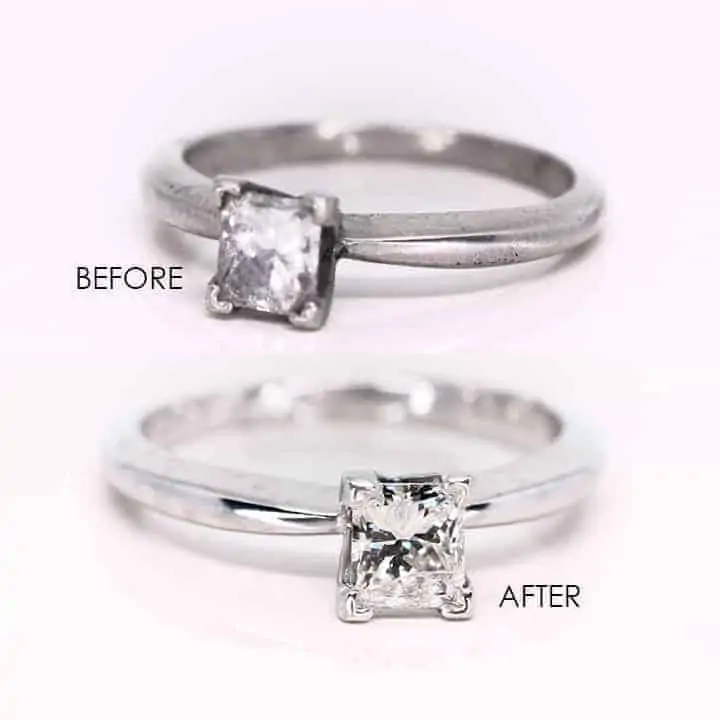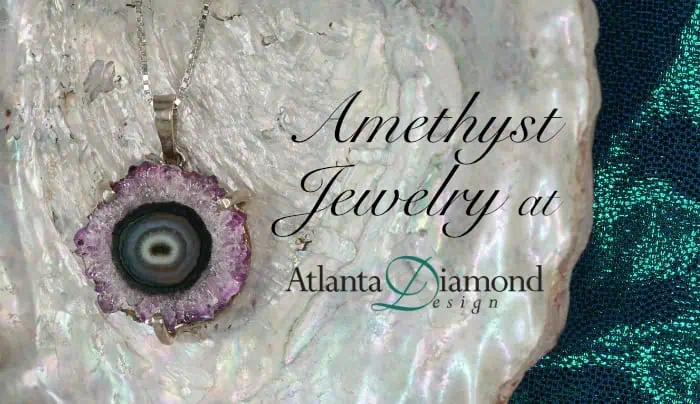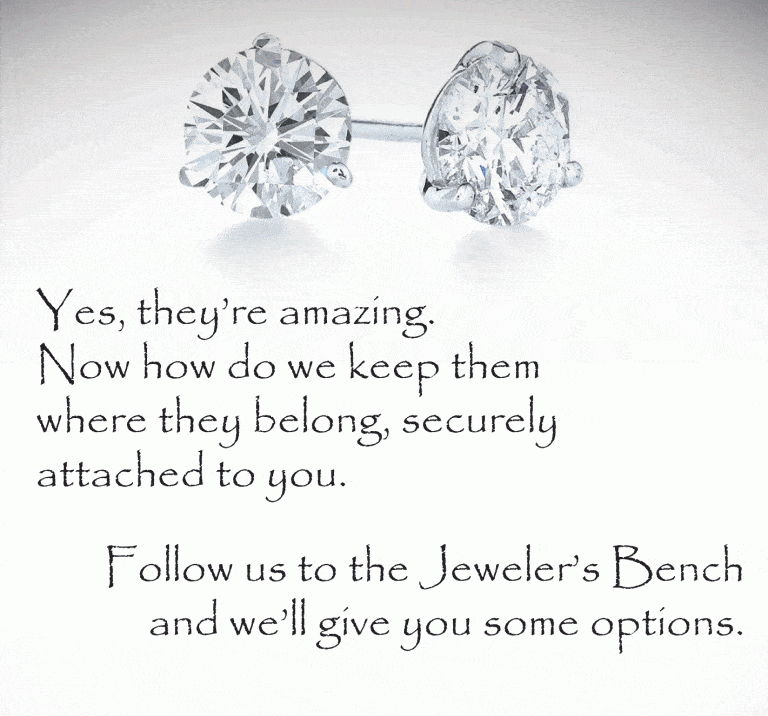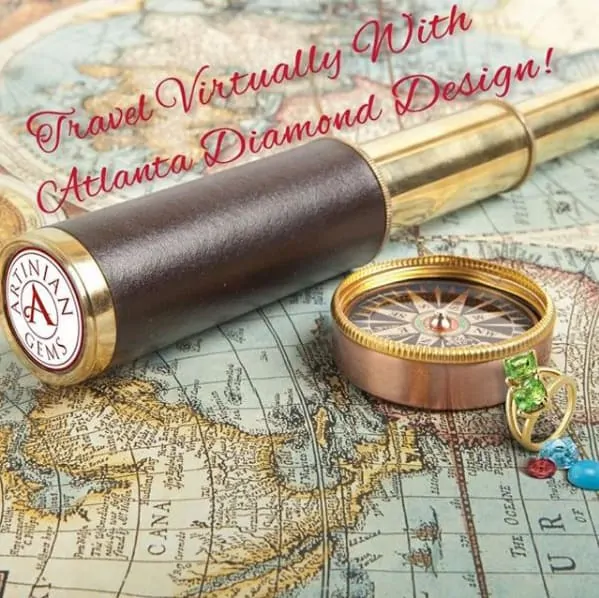Cleaning Fine Jewelry
https://www.youtube.com/watch?v=-4_ckO-Lj_k
Clean Jewelry Is Beautiful Jewelry
Diamonds allure us with their sparkle and scintillation. We are drawn to the shine and shimmer of new jewelry. And yet we see it time and again in our stores – customers come in to shop for engagement rings and insist on the highest quality diamond, but then they don’t keep it clean. It’s like having a luxury car and disguising it as a jalopy. If your diamonds are going to be hidden under a layer of muck, you may as well buy cubic zirconia. Since the dirt builds up over time, you may not even notice that your jewelry looks completely different than the day you took it home from the jewelry store.
Clean Jewelry Is Secure Jewelry
Looks are only surface-deep, or are they? When you do not maintain your jewelry, dirt builds up in the area between the prong and the stone. Over time, the prong becomes further distanced from the stone as dirt continues to build up. Eventually, what is holding your stone in place is dirt instead of your prongs. This leaves you susceptible to losing stones. The best thing is to keep dirt from forming in the first place. This keeps your prongs securely in shape and lowers your maintenance costs.
If your jewelry has been neglected, the best way to start out is by taking it to a professional jeweler for inspection and thorough, deep cleaning. After a neglected ring has been cleaned, stones can become loose and may fall out of the setting. The following instructions are for keeping clean, maintained jewelry looking its best. Even with regular maintenance at home, we still suggest a professional jeweler inspect your jewelry every six months. All of the following instructions are relevant for rings, bracelets, necklaces, and earrings. However, rings tend to get far more wear and tear and therefore, require more frequent and fastidious attention.
https://youtu.be/N6ABxhdtc2o
Ultrasonic
If you take your jewelry to a professional jeweler, chances are, your jewelry will go in a professional grade ultrasonic cleaner. An ultrasonic cleaner contains a solution of concentrated, professional jewelry soap diluted in water and kept at a warm temperature. At the push of a button, ultrasonic waves are sent vibrating through the solution. The heat softens and breaks down the dirt and the ultrasonic waves push dirt out of the tiniest crevices, like between the prongs and stones. After this thorough cleaning, the jeweler will run your jewelry under a hot, pressurized steamer to remove loosened dirt and soap residue.
At Atlanta Diamond Design we offer this service for free. If this is the only way in which you clean your rings, we recommend coming in at least every two months. It takes about 20 minutes, but can be done in as little as 5 minutes. As a rule of thumb, the longer you can leave your jewelry in the cleaner, the more thoroughly your jewelry will get cleaned.
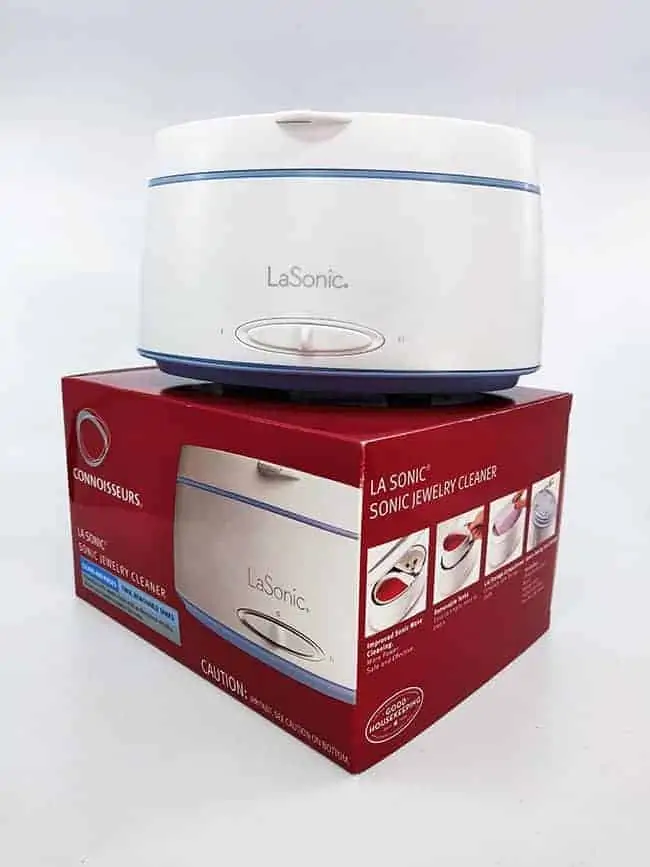
Home Ultrasonic Cleaner
Fortunately, for those too busy to make it to a jeweler every two months, there are home versions of the ultrasonic cleaner that are very affordable. At Atlanta Diamond Design we sell one for just $39 that comes with a sample of the concentrated soap that should last for several months. After that a $19 bottle of refill soap is available and should last a lifetime.
You can leave your diamond jewelry to soak in the solution overnight and then run the machine for 20 minutes. Rinse with water.
NOT ALL GEMSTONES BELONG IN THE ULTRASONIC!
The rule of thumb is red, white, and blue stones can be put in the ultrasonic cleaner. That means rubies, diamonds, and sapphires. However, there are treated, glass-filled or fracture-filled rubies that should not be subjected to heat. Also, ultrasonic waves may cause very small melee or pavee diamonds to fall out of their setting. Your best bet is to ask your jeweler whether your jewelry is safe to put in the ultrasonic.
Stones that should not be exposed to heat or vibration of ultrasonic:
emerald, tanzanite, amethyst, opal, fracture-filled stones (includes many rubies), moonstone, labradorite, pearl, amber, coral, agate, turquoise, quartz, cameo, melee or pave (under 10 points) diamonds, invisible-set diamonds.
Jewelry Cleaner Jar
A simple plastic jar of jewelry cleaning solution comes with a brush & strainer and costs a painless $5. This makes a lovely gift for a friend who just got engaged.
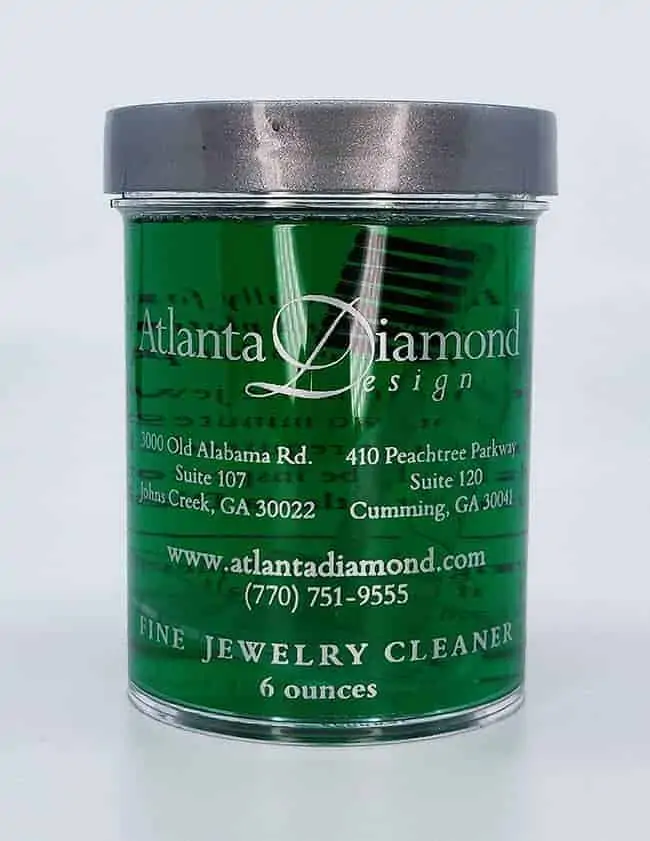
Once a week, drop your ring in before bedtime and leave it in overnight. In the morning, use the brush to remove any muck from the stones. Don’t forget to brush the bottom of your stone. Finally, rinse with water. Jewelry cleaner is also intended for red, white, and blue: rubies, diamonds, and sapphires. Since this method does not expose the jewelry to heat or ultrasonic vibrations, this is a better option for treated stones and tiny melee and pave diamonds. Do not replace the jewelry brush with a toothbrush. Your toothbrush can be too abrasive for your jewelry. Keep a jar at your kitchen and bathroom sinks and place your rings in there before doing dishes or cleaning and you’ll never lose track of your jewelry again, nor will you expose your rings to filth or harsh chemicals.
NOT ALL GEMSTONES BELONG IN THE JEWELRY CLEANER!
Stones that should not be exposed to harsh chemicals of jewelry cleaner:
emerald, opal, pearl, coral, amber, moonstone, labradorite, turquoise, agate, cameo or any other “organic” or porous gemstones.
Special Jewelry Requires Special Attention
White Gold
White gold is plated with rhodium, a white metal from the platinum family. After about a year of normal wear, you will notice the plating wear off, exposing the pinkish hue of the white gold underneath. A jeweler can redo the rhodium plating. At Atlanta Diamond Design we call it Back to Factory Specs. It includes tightening stones, polishing the metal, and finishing it off with rhodium.
Rose Gold
https://youtu.be/hQBVMwth2Ro
The seductive color of rose gold comes from copper. And while rose gold is relatively low maintenance, over time copper can tarnish and cause the surface to darken. Use this recipe:
Fill a glass jar with enough white vinegar to immerse your jewelry. Add a teaspoon of salt and mix. Keep adding salt and mixing until the salt no longer dissolves. Store the jar of solution for whenever your rose gold needs to be detarnished. Dunk your jewelry in the solution; the reaction should be immediate. DO NOT LEAVE YOUR JEWELRY TO SOAK IN THE VINEGAR SOLUTION. Rinse with water.
NOT ALL GEMSTONES BELONG IN THE VINEGAR-SALT SOLUTION!
Stones that should not be exposed to vinegar or salt:
emerald, opal, pearl, coral, amber, moonstone, labradorite, turquoise, agate, cameo or any other “organic” or porous gemstones.
Sterling Silver
https://youtu.be/l6MFsE_1Xgo
Sterling silver oxidizes and blackens. There are two ways to remove the tarnish from sterling silver.
Silver Detarnisher
At Atlanta Diamond Design we sell Dip It. The bottle costs $20 and should last a lifetime, since it’s reusable. Simply pour enough Dip-It in a container to immerse the jewelry. Dunk your jewelry in the Dip-It. The reaction should be immediate. Rinse with water. You can either pour the Dip-It back in the original container, or you can keep the used solution in a jar. Do not eat out of any containers used for Dip-It. Note that some jewelry includes decorative blackening and Dip-It should not be used on these pieces.
NOT ALL GEMSTONES CAN BE EXPOSED TO DETARNISHER!
Stones that should not be exposed to harsh chemicals of silver detarnisher:
emerald, opal, pearl, coral, amber, moonstone, labradorite, turquoise, agate, cameo or any other “organic” or porous gemstones.
Polishing Cloth
The simplest way to get tarnish out of silver is by wiping it with a polishing cloth. It takes more time, but you would be able to preserve any decorative blackening. You can run your polishing cloth through the washing machine when it gets dirty. Just about any soft cloth can be used as a polishing cloth.
NOT ALL GEMSTONES CAN BE WIPED WITH A POLISHING CLOTH!
Stones that should not be exposed to the abrasive surface of jewelry polishing cloth:
opal, pearl, coral, amber, moonstone, labradorite, turquoise, agate, cameo or any other “organic” or porous gemstones. Especially pearls can lose their luster if they are rubbed with a polishing cloth. You are welcome to use a jewelry polishing cloth for the metal elements of your jewelry, but use only a soft, clean, microfiber cloth (like those used to clean eyeglasses) on the delicate gemstones.
https://youtu.be/dtv6646Elm0
Delicate Stones
Emerald, pearls, opal, labradorite, turquoise, cameos, moonstone, amber, coral, agate, and other porous, organic, and delicate stones must be treated with extra special care, as chemicals can strip them of the very qualities that make them valuable. Heat may crack these stones and soap may strip them of their color and luster. Use a soft cloth (like the microfiber cloth used to clean eyeglasses) soaked in warm water to clean these stones. You may choose to use a soft brush to get in small crevices. If you must, a gentle, organic soap may be used, but be sure to dilute it in water. Organic stones should not be stored in plastic baggies, as they need oxygen to maintain their luster. Also, do not store organic jewelry where it will be exposed to intense, direct sunlight.
Storing Jewelry
https://youtu.be/LK8AK4hSOtE
After investing a lot of money in jewelry and time in keeping it clean, it would be a shame to carelessly store your jewelry in a way that damages the metal or stones. For example, diamonds are probably the hardest thing in your jewelry box and can scratch other metal or gemstones if they are allowed to rub against each other. Another common mistake is choking pearls by storing them in plastic baggies that deprive them of oxygen and cause them to become permanently yellow and dull. Safes and safety deposit boxes are not the friendliest storage solution for organic gemstones. Store these in uncoated, untreated, natural wood, cloth, paper, or cardboard that allows them to breathe. It is recommended that these items be worn periodically to absorb some of your body’s oils or you risk permanently losing the luster for which they are valued.
Jewelry is for Going Out
While diamonds are forever, the jewelry it sits in requires special care. When getting ready to go out, putting on your jewelry should be the last step, after makeup, perfume, lotion, or hair products.
Do not wear jewelry while applying products, washing your hands, swimming, exercising, cleaning, or cooking. Certainly do not wear jewelry while doing labor. Even though diamonds are very resilient, they can still be chipped. Harsh chemicals and abrasive textures damage the shiny finish of the metal and can make your prongs more brittle. And wearing your rings while lifting heavy objects can cause them to bend or break. Some of you insist on wearing jewelry at all times and never taking it off, even while showering, sleeping, and gardening. Just know that you will spend more money on maintenance for your ring and are at a higher risk of losing stones. Also, you will probably sooner reach the point where your entire setting will need to be replaced. If you are highly sentimental, know that your ring will last longer if you protect it by only wearing it to go out.
Clean Jewelry Still Needs a Jeweler
Take your jewelry to a professional jeweler every six months for inspection to ensure your stones are secure in their setting.


